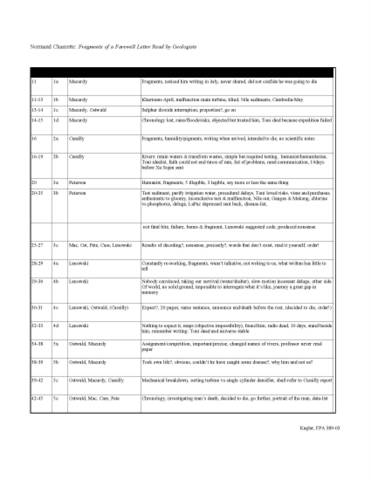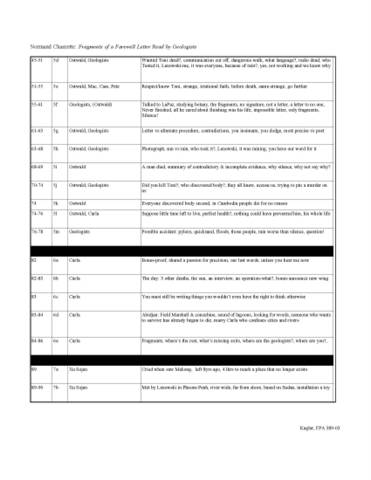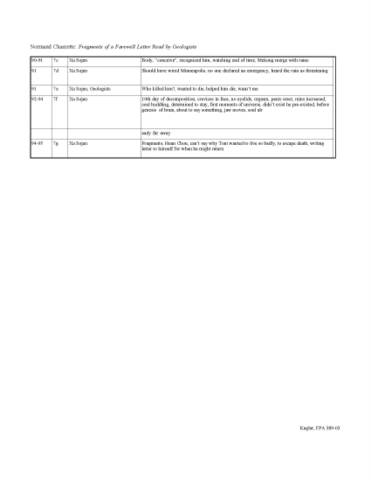Say what? Geology and Medical Jargon exposed (by DWhidden)
* The Unit was designed to accomplish:
The extraction of underwater sediments in tropical regions;
Water purification in tropical regions.
*It was essential that the unit be tested when the water level reached its highest point. This water level makes it possible to achieve a geothermal capacity up to one hundred times greater than its hydroelectric potential.
-Geothermal: Of or relating to the internal heat of the earth.
-Capacity: Ability to perform or produce; capability.
-Hydroelectric: Of or relating to or used in the production of electricity by waterpower; "hydroelectric power"
* Sediments are explored and tested after being extracted from riverbeds
-Sediment is any particulate matter that can be transported by fluid flow and which eventually is deposited as a layer of solid particles on the bed or bottom of a body of water or other liquid. Deposited sediments are the source of sedimentary rocks, which can contain fossils of the inhabitants of the body of water that were, upon death, covered by accumulating sediment.
*Sediments are to be dissolved: the water reserves coming from the feeding channel showed that the sediments collected in the riverbed could not be dissolved using carbonic gas
-Channel: A tubular passage for liquids; a conduit.
-Reserve: Something kept back or saved for future use or a special purpose.
-Carbonic Gas: A colorless, odorless, incombustible gas, CO2, formed during respiration, combustion, and organic decomposition and used in food refrigeration, carbonated beverages, inert atmospheres, fire extinguishers, and aerosols. Also called carbonic acid gas. (Carbon Dioxide)
* The stilling tank:
-Contained gases, steam or water
-Also contained pressurized methane which kept the rocks dry (presumably the heated rocks in the earths’ core that the water is being pumped through)
-Either the methane or the rocks were cooled off by a fluid derived by an external source
*There is an evaporation cycle of the water reserves, part of which is accomplished through a system of artificial distribution of hydraulic energy
-Evaporation: The process by which any substance is converted from a liquid state into, and carried off in, vapor; as, the evaporation of water.
-Hydraulic energy: Energy created by water under pressure.
*Water is purified by filtering the residues and classifying or separating the denser molecules
-A denser object (such as iron) will have less volume than an equal mass of some less dense substance. Volume is a quantification of how much space an object occupies.
-Light molecules stay near the top, and heavier, denser molecules sink lower and lower.
*The denser molecules are obtained by using a spiral turbine operated on hydraulic pressure
- A Turbine is a rotary engine that extracts energy from a fluid flow. The simplest turbines have one moving part, a rotor-blade assembly. Moving fluid acts on the blades to spin them and impart energy to the rotor. Early turbine examples are windmills and water wheels.
- Hydraulics is a branch of science and engineering concerned with the use of liquids to perform mechanical tasks. Typically, the fluid used in a hydraulic system is an incompressible liquid such as water or oil. Pressure is applied by a piston to fluid in a cylinder, causing the fluid to press on another piston that delivers energy to a load.
*The recuperated irrigation water is treated (i.e., level of toxic residue reduced) while being retained in a chamber equipped with bidirectional valves attached to 2 delivery meters capable of alternating their energy forces
-Irrigate: Supply water to (land or crops) by means of channels. (See p.20 Frag)
-Chamber: An enclosed space or compartment.
-Bidirectional: Moving or operating in two usually opposite directions
-Valve: Any of various devices that regulate the flow of gases, liquids, or loose materials through piping or through apertures by opening, closing, or obstructing ports or passageways.
-Delivery: The act of transferring to another.
-Meter: Any of various devices designed to measure time, distance, speed, or intensity or indicate and record or regulate the amount or volume, as of the flow of a gas or an electric current.
*A single-cylinder turbine upstream and a final-phase purifier operating with the help of a magnetic field downstream
-Purifier: An apparatus for removing impurities
- A Magnetic Field is said to exist in a region if a force can be exerted on a magnet. If a compass needle is deflected when it is put at a particular location, we say a magnetic field exists at that point, and the strength of the field is measured by the strength of the force of the compass needle. All known magnetic fields are caused by the movement of electrical charges.
FLAWS IN THE UNIT -
Problem #1: The sorting turbine didn’t work in the main delivery meter
*Because: One of the cylinders (the main cylinder) in the turbine was tilted too far in relation to the spirals axis
*Result: The water reserves headed for the discharge channel interflowed with those from the main feeding channel
-I.E., the proceeds from the reserves went into the recuperated water and vice versa.
Solution: Replace the defective cylinder and fill the sorting spinner by hand
Problem #2: The water reserves coming from the feeding channel showed that the sediments collected in the riverbed could not be dissolved using carbonic gas
* Result: The headwaters of the
Solution: Move on to
EQUIPMENT LISTED
*2 Channels: Feeding and Discharge
*Stilling Tank
*2 or more Turbines: Mention of a ‘main turbine’; also a ‘sorting’ and ‘spiral’
*2 or more Cylinders: Mention of a ‘main cylinder’
*A Chamber equipped with Bidirectional Valves attached to 2 Delivery Meters
*1 of the 2 Delivery Meters described as a Main meter
WHAT CAN I PIECE TOGETHER ABOUT HOW THE SYSTEM WORKS?
*They sought to produce electricity through the heat of the earth’s interior rather than with waterpower
*The unit was extracting sediment from the riverbed (to test the quality of the water?)
*The geologists are using carbon dioxide to dissolve the sediments
*This Carbon Dioxide is contained in a stilling tank
*The sediments of the
*The water needs to be evaporated in order to be purified (?)
*The treatment of the recuperated water occurs in the chamber
*The recuperated water and the reserve water must be kept separate
CARLA VAN SAIKAN
Alluvium is soil land deposited by a river or other running water. A river is continually picking up and dropping solid particles of rock and dirt from its bed throughout its length. Where the river flow is fast, more particles are picked up than dropped. Where the river flow is slow, more particles are dropped than picked up. Areas where more particles are dropped are called alluvial or flood plains, and the dropped particles are called alluvium.
Triazolam (Halcion®, Novodorm®, Songar®) belongs to benzodiazepine group of drugs. It is commonly prescribed for insomnia, and its short half-life (approximately 3 hours) makes it ideal for this use because it thereby avoids morning drowsiness. Questions exist about its safety because it has a fairly narrow therapeutic window. Also, some have suggested that it causes hallucinations, amnesia, paranoia and verbal and physical aggression. On October 2, 1991, the Committee on the Safety of Medicines (CSM) banned sales of Triazolam in the
Lobe: A subdivision of a body organ or part bounded by fissures, connective tissue, or other structural boundaries. Upper lobe here refers to the lungs.
Alveolus: A tiny, thin-walled, capillary-rich sac in the lungs where the exchange of oxygen and carbon dioxide takes place. Also called air sac.
Ablation is defined as the removal of material from the surface of an object by vaporization, chipping, or other erosive processes. Often used in the context of laser ablation, a process by which the molecular bonds of a material are dissolved by a laser. In medicine, ablation is the same as removal of a part of biological tissue, usually by surgery.
Pneumonectomy: Surgical removal of all or part of a lung.
Thoracoplasty: Surgical removal of part of the ribs to cause the collapse of a diseased lung.
Tuberculosis: An infectious disease of humans and animals caused by the tubercle bacillus and characterized by the formation of tubercles on the lungs and other tissues of the body, often developing long after the initial infection.
TONI VAN SAIKANS’ MEDICAL RECORD
B.P.:
- Systolic between 90 and 135 mmHg (12 to 18 kPa)
- Diastolic between 50 and 90 mmHg (7 to 12 kPa)
Cholesterol:
The American Heart Association (http://www.americanheart.org/cholesterol/about.jsp) provides a set of guidelines for total (fasting) blood cholesterol levels and risk for heart disease:
Interpretation | ||
<200 | <5.2 | Desirable level corresponding to lower risk for heart disease |
200-239 | 5.2-6.2 | Borderline high risk |
>240 | >6.2 | High risk |
Hemoglobin: Hemoglobin is the protein molecule in red blood cells which carries oxygen from the lungs to the body's tissues and returns carbon dioxide from the tissues to the lungs. The iron contained in hemoglobin is responsible for the red color of blood.
What are normal hemoglobin values?
· Children: 11-13 gm/dl
· Adult males: 14-18 gm/dl
Adult women: 12-16 gm/dl
Ectomorph: An individual having a lean, slightly muscular body build in which tissues derived from the embryonic ectoderm predominate.
Leukocytosis is an elevation of the white blood cell count (the leukocyte count) above the normal range. The normal adult human leukocyte count in peripheral blood is 4.4-10.8 x 109/L. A white blood count of 11.0 or more suggests leukocytosis. Leukocytosis is very common in acutely ill patients. It occurs in response to a wide variety of conditions, including viral, bacterial, fungal, or parasitic infection, cancer, and exposure to certain medications or chemicals.
Blood Type: One of many groups into which a person's blood can be categorized, based on the presence or absence of specific antigens in the blood. Blood type is inherited.
Parenchyma: Anatomy. The tissue characteristic of an organ, as distinguished from associated connective or supporting tissues.
Scar Tissue: Dense fibrous connective tissue that forms over a healed wound or cut.
In Munchausen syndrome, the sufferer feigns, exaggerates, or creates symptoms of illnesses in himself in order to gain attention, sympathy, and comfort from medical personnel. The role of "patient" is a familiar and comforting one, and it fills a psychological need in the man or woman with Munchausen's. There is some controversy on the exact causes of the syndrome, but an increased occurrence has been reported in healthcare professionals and close family members of people with a chronic illness.
Potassium level: The normal range is 3.7 to 5.2 mEq/L.
Protein: Finding protein in the urine is probably the best test for screening for kidney disease, although there may be a number of causes for an increased protein level in the urine.
Casts: Tubules in the kidneys secrete proteins. Under some circumstances, these proteins precipitate out to form little cylindrical impressions of the tubules called casts. If anything is present in the tubules at the time, it gets trapped in the protein casts.
Urinary MHPG: Early case studies demonstrated that in bipolar patients, urinary MHPG levels were lower during the depressed phase and higher during the manic phase than during periods of euthymia.
Calcium level: If a person is eating a normal diet, the expected amount of calcium in the urine is 100 to 300 mg/day. If eating a diet low in calcium, the amount of calcium in the urine will be 50 to 150mg/day.
Myopia, also known as nearsightedness or short-sightedness, is a refractive defect of the eye, where the person affected usually can see nearby objects clearly but distant objects appear blurred. Myopia of 6.00 diopters or greater is considered high, or severe, myopia.
The Babinski reflex or Babinski sign is a reflex that can identify disease of the spinal cord and brain.
Paludism: The morbid phenomena produced by dwelling among marshes; malarial disease or disposition. (Basically, Malaria)
BIBLIOGRAPHY:
Answers.com
AskOxford
Bio.Edu
English-dictionary.us
Engnet Engineering dictionary
Medline Plus Medical Encyclopedia
USGS.com
Wikipedia



